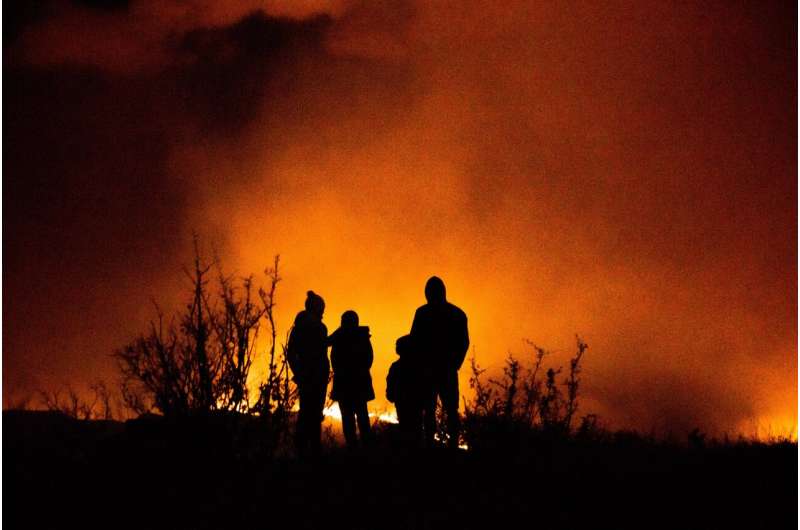This article has been reviewed according to Science X's editorial process and policies. Editors have highlighted the following attributes while ensuring the content's credibility:
fact-checked
trusted source
proofread
Q&A: Why wildfire smoke pollution is so intense right now—and likely to get worse

Much of the Northeastern United States, including Washington, D.C., and the George Washington University, spent the last few days under a haze of wildfire smoke that obscured sunlight, closed outdoor institutions like local parks and the National Zoo and forced the cancelation of activities from baseball games to Broadway shows.
Produced by more than 400 wildfires in Canada, with a particularly severe concentration in Quebec, the smoke caused record-breaking levels of air pollution and stoked fears about the ripple effects of climate change.
Researchers from GW's Climate and Health Institute (CHI) have been studying these evolving issues for years. GW Today spoke to CHI Director Susan Anenberg, professor and chair of environmental and occupational health in the Milken Institute School of Public Health; Katelyn O'Dell, a postdoctoral research scientist in the Milken Institute SPH Department of Environmental and Occupational Health; and Neelima Tummala, CHI codirector and an otolaryngologist with the Medical Faculty Associates.
GW Today: Many people on the East Coast have never experienced severe wildfire-related air pollution before, though it's increasingly common on the West Coast. Are we likely to have to face more events like this in the future?
Susan Anenberg: Climate change is fueling longer and more intense fire seasons. As a result, we expect that the U.S. population will experience more smoky conditions in the future, and that wildfires will become a growing contributor to total pollution levels. With climate change, it will be harder to attain our outdoor air quality standards in the U.S. It is imperative that we reduce greenhouse gases now to ensure that all people have clean air to breathe in the future.
On a structural level, we must reduce fossil fuel combustion that leads to worsening wildfire smoke events driven by climate change. We won't be able to solely rely on the kind of air quality improvement approaches we've used in the past, like diesel particulate filters and catalytic convertors on vehicles and scrubbers on power plants. We have to slow and reverse climate change to avoid worsening air pollution in the future.
GWT: What kinds of air-pollutant particles do wildfires produce?
SA: Wildfires produce a variety of particles and gases from the burning of vegetation such as organic carbon, black carbon, nitrogen oxides, carbon monoxide and hazardous air pollutants. It's also important to remember that materials in our built environment may be burning too. Those could include plastics and other materials that release a variety of noxious chemicals, asbestos and other compounds that can make us sick.
GWT: What are the health effects of these particles? Who is most at risk?
SA: The mixture of particles and gases in wildfire smoke are associated with respiratory symptoms like shortness of breath, reduced lung function and increased risk of asthma exacerbation and emergency room visits, as well as cardiovascular effects like heart attack and stroke. Fine particles that are so small that they can get really deep into our lungs and even into our blood stream can affect every organ of the body and are associated with premature death.
Vulnerable populations include the elderly, children, people with preexisting respiratory or cardiovascular disease, people who are pregnant and people who work outdoors.
GWT: How can wildfires cause air pollution so far away from their sources of origin?
SA: Air movement around the planet is affected by large scale pressure systems. In this case, a low-pressure system has set up over Nova Scotia and has stayed stagnant for a couple of days. The low-pressure system causes air to move in a counter-clockwise direction, bringing smoky air from Quebec down to the East Coast of the U.S. Until the direction of air movement changes or it rains, the smoky air will continue to flow from north to south.
GWT: What can individuals and families do to stay safe and healthy when air pollution is severe? Are there things we should do or have at home?
Neelima Tummala: The most important thing when air pollution levels are high outdoors is to try to minimize outdoor activities. This is especially important for older adults, babies and children, women who are pregnant and individuals with respiratory conditions such as asthma or underlying heart disease.
If needing to spend time outdoors, wearing an approved N95 respirator mask can help. In general, these masks are safe for children over two years of age, although it's a good idea to check first with the child's pediatrician.
When indoors and in the car, keeping the windows closed is helpful. Also try to avoid activities that worsen indoor air quality such as smoking, burning candles and frying foods.
And finally, obtaining a portable air filter for the home or installing a high efficiency filter (MERV rating of 13 or higher) can help improve indoor air quality.
Katelyn O'Dell: It's always a good idea to check outdoor air quality before outdoor activities. Good sources for this information are local air quality agencies and the Environmental Protection Agency (EPA). Sometimes when the smoke travels to us from distant fires it may not look or smell like smoke outside, so our eyes and nose are not always the best indicators of smoke.
If you don't have an air purifier, there are instructions online on how to make a DIY filter (like this video from the Washington Post). Similar filters have been shown to improve indoor air quality during smoke events.




















